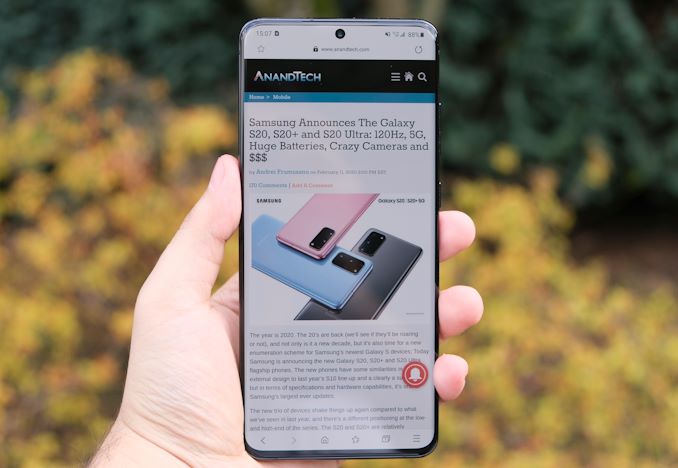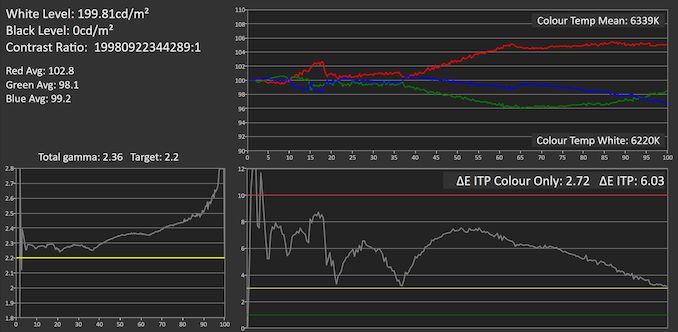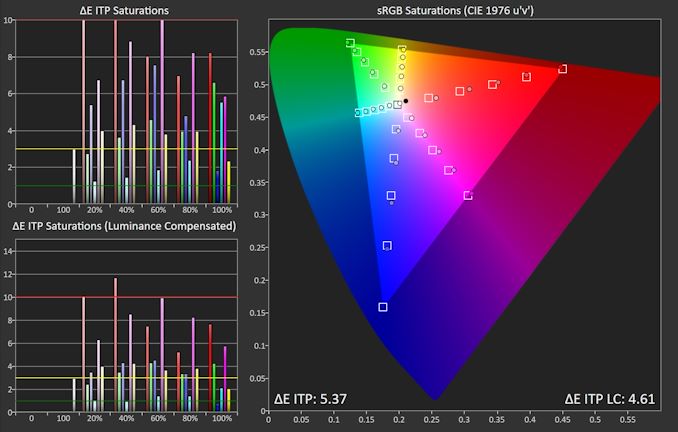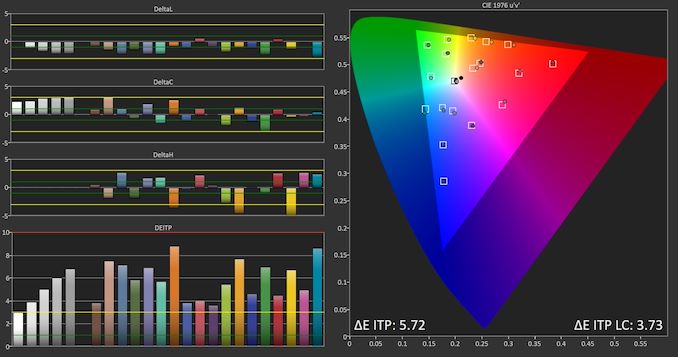The Samsung Galaxy S20+, S20 Ultra Exynos & Snapdragon Review: Megalomania Devices
by Andrei Frumusanu on April 3, 2020 9:30 AM ESTDisplay Measurement
The Galaxy S20’s screens follow the same recipe that we found on the S10 and Note10 series, and other than the 120Hz display modes, the new panels don’t have any major new changes to them when it comes to features or display quality changes.
We move on to the display calibration and fundamental display measurements of the Galaxy S20 screen. As always, we thank X-Rite and SpecraCal, as our measurements are performed with an X-Rite i1Pro 2 spectrophotometer, with the exception of black levels which are measured with an i1Display Pro colorimeter. Data is collected and examined using Portrait Display's CalMAN software.

In terms of brightness, the S20 Ultra and S20+ fall in line with what we’ve seen from Samsung phones over the past few generations. The panel goes up to 325 nits in maximum manual brightness mode, and boosts up to 731 nits at full screen white when under auto brightness and high ambient light. The lower the APL of your content, the brighter the screen will become.
The S20 series is identical to the S10 series when it comes to the display settings; we find the phone comes by default in a “Vivid” mode with a larger color gamut target for all content. But what’s new here is that this generation Samsung has included a color temperature slider offering not only a few discrete choices between cool and warm, but it also gives the option for fine-tuning the RGB balance as well. Nevertheless, the accurate color profile for the phone is the “Natural” one which aims for sRGB colors for default contents and is able to support wider color targets for color managed applications.
Unfortunately, the S20 doesn’t really behave any different to the S10 series, and we find the same characteristics in the calibration between the phones. The worst offender here is the color temperature which is far too warm at an average of 6330K across all grey levels, and a white falling in at 6220K. Samsung keeps doing this year after year and at this point I just don’t know what the point is anymore in hoping that they would finally get it right.
The resulting gamma is also quite off and will wildly vary in the measurement depending on your pattern’s APL. We’ve had tons of phones fail at this aspect as the panels are calibrated without consideration of the CABC mechanisms of the display – for some vendors it’s even possible to retrace the methodologies and showcase where they went wrong in the calibration.
At this point I should note that we’ve slightly revamped our display reporting methodology, and have now moved from showcasing dE2000 error values to the newer dEITP standard, which is more strict in its error figure handling.
The S20 Ultra here ends up with a dEITP of 6.03 because of the color and luminosity errors, and just the color error would lend it a dEITP of 2.72. I’ll be remeasuring more devices and bring back comparison charts on other devices with the new dE standard in upcoming reviews.
Saturation targets for the S20 are also in line with what we’re used to from Galaxy phones – not great, but not totally bad either. The major issue again is the shift of the spectrum towards reds.
The Gretag MacBeth chart with common human color tones is also just somewhat acceptable, with the commonality of gamma errors, but also some larger hue errors due to the shift towards reds.
A Typical Galaxy Display
Overall, the S20 series come with what I’d call typical Galaxy displays. The panel is fantastic quality, and there’s nothing to criticize it in terms of its intrinsic qualities. The calibration is a bit more lackluster and in-line with what we’ve become accustomed from Samsung, key points being that the gamma is off yet again, and the Natural display mode is also too warm, yet again. It’s not a deal breaker, but Samsung has done better in the past. In any case, they remain high quality displays which are just short of being outstanding.
















137 Comments
View All Comments
Suraj tiwary - Sunday, April 12, 2020 - link
When will u start testing with Spec2017? Even arm despite being a marketer of its SOC uses both (spec2017 shows less scores) & U despite being a reviewer are too late.xGeoThumbs - Thursday, April 16, 2020 - link
I always come to these reviews for the photography comparison. They are done really well. Really surprised by the oversharpening on the Snapdragon model compared to the Exynos. The Pixel 4 would also do much better if you find the time to use the Night Sight feature during daytime photography. It improves white balance and detail rendition. Keep it up!damianrobertjones - Thursday, April 23, 2020 - link
The Amazon reviews, for this phone aren't the best in the world.Junphy - Thursday, May 7, 2020 - link
Why not add Mediatek Dimensity 1000 for a comparison ?hemingway9000 - Saturday, June 6, 2020 - link
Hi,could you guys somehow please investigate this? https://www.youtube.com/watch?v=h4F0L-soM1I
It seems that this "Game Optimizer Service" seems to be behind the problems caused in the s20 performance. It would be great if you could do a deep dive into it. Thank you.
Archer_Legend - Thursday, August 13, 2020 - link
Usaul amazing rewiew, i read it again after 6 months and it is done very wellspicekitkat - Monday, October 5, 2020 - link
Great article, when a phone comes out I'm really interested in the sound of that phone, hope it will have this sound: https://chakushinon123.com/samsung-s20-ultra/